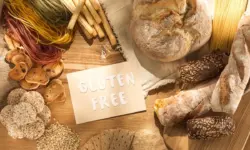A Guide to Reading Product Labels for Those on a Gluten-Free Diet
When you’re gluten-free, the ingredients list becomes your best friend. Look out for wheat, barley, rye, and oats unless they are specifically labeled as gluten-free. Manufacturers are required to list any potential sources of gluten in their products. However, some ingredients derived from gluten-containing grains may not always be obvious. Terms like “modified food starch,” “natural flavors,” or “hydrolyzed vegetable protein” can sometimes hide gluten, so extra vigilance is key.
Certifications such as the “Certified Gluten-Free” label are reliable indicators that a product meets strict gluten-free standards. Organizations like the Gluten-Free Certification Organization (GFCO) and others ensure that products undergo rigorous testing and adhere to gluten-free protocols. These labels provide peace of mind and simplify shopping for gluten-free individuals.
Even if a product’s ingredients list seems safe, cross-contamination during manufacturing can still occur. Look for statements like “May contain traces of wheat” or “Processed in a facility that also processes wheat.” While these warnings are voluntary, they indicate potential risks for those with severe gluten sensitivity.
Beyond the ingredients list, the nutritional label offers valuable insights. Pay attention to fiber sources—if listed, they should be from non-gluten grains like rice or corn. Additionally, check for any hidden gluten sources in vitamins, preservatives, or food additives, which might not be immediately obvious.
Sometimes, product labels can be vague or omit gluten-containing ingredients. In such cases, contacting the manufacturer directly can provide clarity. Asking specific questions about their gluten-free practices and cross-contamination prevention measures ensures you make informed choices.
Mastering the art of reading product labels empowers you to maintain a gluten-free lifestyle effectively. It requires diligence and a keen eye for details, but the benefits—better health and peace of mind—are well worth the effort.
Understanding product labels is pivotal for those on a gluten-free diet, ensuring every purchase aligns with their dietary needs and preferences. By arming yourself with knowledge and staying vigilant, you can confidently navigate grocery aisles and enjoy a fulfilling gluten-free life.
Decoding Gluten-Free Labels: Essential Tips for Safe Shopping
Firstly, what does “gluten-free” really mean? When a product is labeled as gluten-free, it indicates that it contains less than 20 parts per million (ppm) of gluten. This threshold is considered safe for most people with gluten sensitivity or celiac disease, as even small amounts of gluten can trigger adverse reactions.
But here’s the catch—some products may claim to be “wheat-free” or “grain-free,” but that doesn’t necessarily mean they are gluten-free. Gluten can hide in various forms, such as barley or rye, so it’s crucial to look beyond the surface claims and check the ingredients list thoroughly.
Reading labels becomes your superpower in the quest for gluten-free goodies. Always scan the ingredients list for any potential sources of gluten. Ingredients like wheat, barley, rye, and oats (unless specified as gluten-free oats) are clear indicators that the product is not safe for a gluten-free diet.
Moreover, keep an eye out for dedicated gluten-free certifications. Brands that undergo rigorous testing and meet specific standards to earn certifications like the Gluten-Free Certification Organization (GFCO) seal offer added assurance. These certifications often involve regular inspections and testing of products to ensure compliance with gluten-free guidelines.
Shopping in the produce and fresh meat sections of the grocery store can also simplify your gluten-free journey. Whole foods like fruits, vegetables, meats, and dairy are naturally free from gluten, making them safe choices without the need for deciphering complex labels.
When in doubt, don’t hesitate to reach out to manufacturers or consult reliable sources for gluten-free information. Websites of celiac disease organizations or gluten-free communities often provide updated lists of safe products and brands.
Mastering the art of gluten-free shopping empowers you to enjoy a varied and safe diet without compromising on taste or nutrition. With these essential tips in mind, you’re well-equipped to navigate the shelves confidently and savor every gluten-free bite.
Mastering Gluten-Free Grocery Shopping: Your Label Reading Guide
Firstly, what exactly does “gluten-free” mean on a food label? Essentially, it indicates that the product does not contain any gluten, a protein found in wheat, barley, and rye. This is particularly important for individuals with celiac disease or gluten sensitivity, as even trace amounts of gluten can trigger adverse health effects.
When scanning food labels, your eyes should gravitate towards the ingredients list. Look for items that explicitly state “gluten-free” or are naturally devoid of gluten-containing grains. Focus on products made with alternative flours like rice, corn, or almond flour, which are safe bets for those avoiding gluten.
Moreover, keep an eye out for sneaky sources of gluten that might not be as obvious. Ingredients such as malt flavoring, soy sauce (unless specified gluten-free), and certain food additives can harbor gluten. Familiarize yourself with these potential culprits to ensure your shopping cart remains gluten-free compliant.
Understanding label certifications can also streamline your shopping experience. Look for reputable gluten-free certification symbols like those from the Gluten-Free Certification Organization (GFCO) or the Celiac Support Association (CSA). These logos reassure consumers that rigorous testing and standards have been met to guarantee a gluten-free product.
In addition to avoiding gluten, it’s essential to prioritize nutritional balance. Opt for gluten-free products that are rich in vitamins, minerals, and fiber. Choose whole foods whenever possible and minimize reliance on heavily processed gluten-free substitutes, which may lack essential nutrients.
By mastering the art of reading food labels, you empower yourself to make healthier choices while navigating the gluten-free landscape with confidence. Armed with these label reading tips, you can fill your pantry with delicious gluten-free options that align with your dietary needs and preferences. Happy shopping!
Gluten-Free Product Labels Demystified: What You Need to Know
Navigating the world of gluten-free products can be a daunting task, especially with the myriad of labels and claims out there. Understanding what these labels mean is crucial for those with gluten sensitivities or celiac disease. Let’s break down the essentials.
Firstly, what does “gluten-free” actually mean? Products labeled as gluten-free are manufactured without wheat, barley, or rye, or any hybrid strains of these grains that contain gluten. This is particularly important for individuals who must avoid gluten for health reasons.
When you see a product labeled “certified gluten-free,” it means that the item has undergone rigorous testing to ensure it meets gluten-free standards. This certification is typically issued by recognized organizations that set specific thresholds for gluten content, ensuring safety for consumers.
However, not all gluten-free products carry a certification. Some may simply state “gluten-free” on their packaging. In these cases, it’s important to check the ingredient list for any potential sources of gluten. Ingredients like malt flavoring or modified food starch can sometimes contain gluten, so a careful review is necessary.
Reading the entire label is essential. Manufacturers are required to clearly list any potential allergens, including wheat or gluten-containing ingredients. This transparency helps consumers make informed choices about what they’re purchasing.
For those new to gluten-free living, it can feel like learning a new language. But with awareness and a bit of practice, deciphering gluten-free labels becomes second nature. Remember, the goal is to ensure your dietary choices support your health needs without sacrificing flavor or enjoyment.
Understanding gluten-free product labels empowers you to make confident decisions about your diet. Whether you’re gluten-sensitive, have celiac disease, or are exploring gluten-free options out of curiosity, knowing what these labels signify ensures you can shop smarter and eat well.
Navigating Food Labels on a Gluten-Free Diet: A Practical Approach
Firstly, look for the obvious: labels that explicitly state “gluten-free.” This indication ensures the product meets strict regulatory standards, typically containing less than 20 parts per million (ppm) of gluten. Such clarity eliminates guesswork and minimizes the risk of accidental gluten ingestion.
Next, scrutinize the ingredient list. Ingredients are listed in descending order by weight, so gluten-containing grains like wheat, barley, rye, and oats (unless certified gluten-free) should raise red flags. Sometimes, manufacturers use terms like “wheat-free” or “no gluten ingredients,” which are helpful but not synonymous with gluten-free.
Be wary of cross-contamination. Shared production lines or equipment can lead to trace amounts of gluten in products labeled gluten-free. Look for statements like “processed in a facility that also processes wheat” or “may contain traces of wheat.” For those with severe gluten intolerance or celiac disease, avoiding such products might be necessary.
Understanding food labels involves more than just avoiding gluten-containing ingredients. It requires awareness of hidden sources of gluten, such as additives, flavorings, and stabilizers. Terms like modified food starch, malt flavoring, and hydrolyzed vegetable protein often contain gluten unless specified otherwise.
When in doubt, consult reliable resources or contact the manufacturer directly. Many brands provide customer service contact information on their packaging. They can clarify any doubts regarding gluten content, production practices, or ingredient sourcing.
Navigating food labels on a gluten-free diet demands attention to detail and familiarity with labeling regulations. By mastering these skills, you empower yourself to make informed choices that support your health and well-being. Happy label reading!
Gluten-Free Labeling 101: Key Ingredients to Watch Out For
Navigating gluten-free foods can be daunting, but understanding key ingredients is crucial for making informed choices. When scanning labels, gluten, a protein found in wheat, barley, and rye, must be avoided by those with gluten intolerance or celiac disease. Here’s a breakdown of ingredients to watch out for:
Wheat: Found in various forms like flour, bran, and germ, wheat is a primary source of gluten. Be cautious of derivatives such as semolina and durum.
Barley: Often hidden in malt products, barley contains gluten. Watch for ingredients like malt vinegar or malt extract in processed foods and beverages.
Rye: This grain contains gluten and is commonly found in bread, cereals, and rye-based alcoholic beverages. Check labels carefully for rye flour or malted rye ingredients.
Oats: While oats themselves are gluten-free, cross-contamination during processing is common. Look for certified gluten-free oats to ensure safety.
Gluten-Free Certification: Products labeled gluten-free undergo rigorous testing to meet safety standards. Look for certifications from recognized organizations to ensure compliance.
Hidden Sources: Gluten can hide in unexpected places like sauces, dressings, and processed meats. Ingredients such as modified food starch and hydrolyzed vegetable protein may contain gluten unless specified as gluten-free.
Navigating gluten-free labeling requires diligence, but resources like ingredient lists and certifications can simplify the process. By staying informed and checking labels thoroughly, individuals can confidently choose gluten-free options that suit their dietary needs.
Insider’s Guide to Gluten-Free Product Labels: Ingredients to Avoid
Navigating gluten-free product labels can be a daunting task, especially with the myriad of ingredients to decipher. For those following a gluten-free diet due to celiac disease or gluten intolerance, understanding what ingredients to avoid is crucial for maintaining health and well-being.
One of the primary culprits to watch out for is wheat, a common source of gluten. While most people associate gluten with wheat, it’s essential to note that other grains like barley and rye also contain gluten. This means ingredients derived from these grains, such as barley malt extract or rye flour, should be avoided if you’re sensitive to gluten.
Another tricky category is food additives and flavorings. Ingredients like modified food starch, which can be derived from wheat, and maltodextrin, often sourced from corn but potentially cross-contaminated with gluten during processing, require careful scrutiny. Even soy sauce, a staple in many dishes, can contain gluten unless it’s specifically labeled as gluten-free.
For those with a sweet tooth, it’s important to be cautious of desserts and candies. Many of these products contain ingredients like dextrin or caramel coloring, which might include gluten unless specified otherwise. Checking the label or opting for products labeled as gluten-free can prevent accidental consumption of gluten-containing ingredients.
Navigating the world of gluten-free labels isn’t just about avoiding specific ingredients; it’s also about understanding cross-contamination risks. Manufacturers may process gluten-free products on shared equipment with gluten-containing products, leading to potential contamination. Look for certifications or statements on the packaging that assure stringent manufacturing practices to minimize these risks.
By staying informed and reading labels attentively, individuals can confidently select gluten-free products that align with their dietary needs and preferences. This proactive approach ensures a safer and more enjoyable gluten-free lifestyle, free from the worries of accidental gluten consumption.
Frequently Asked Questions
What are the key certifications to look for on gluten-free labels?
Learn about the essential certifications to verify on gluten-free labels, ensuring products meet stringent standards for gluten absence. Discover how these certifications guarantee safe choices for gluten-sensitive individuals.
Are there common hidden sources of gluten in products?
Discover common hidden sources of gluten in various products with our concise guide. Learn where gluten might unexpectedly lurk to make informed choices.
How can I safely navigate potential cross-contamination risks on labels?
Learn how to safely manage cross-contamination risks from food labels by carefully reading ingredient lists, checking for allergen warnings, and choosing products with clear labeling practices.
How can I identify gluten-containing ingredients on labels?
Learn how to easily identify gluten-containing ingredients on labels with our concise guide. Discover key terms to look for, such as wheat, barley, and rye, and understand how to spot hidden sources of gluten in food products. Equip yourself with essential knowledge for making informed dietary choices.
What does “gluten-free” mean on a product label?
The term ‘gluten-free’ on a product label indicates that the item does not contain any gluten, a protein found in wheat, barley, and rye. Products labeled as gluten-free are suitable for individuals with gluten-related disorders such as celiac disease or gluten intolerance.


